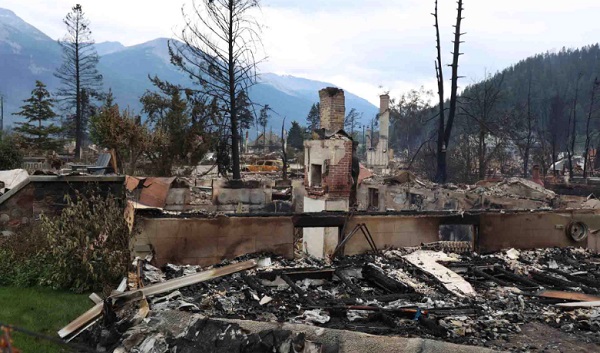Alberta
Province providing 250 modular homes to help ease housing crisis in Jasper

Supporting Jasper residents’ return home |
Alberta’s government continues to support recovery efforts in Jasper and is helping residents return to the community with $112 million in funding for interim housing.
Alberta’s government continues to support recovery efforts in Jasper and is helping residents return to the community with $112 million in funding for interim housing.
Alberta’s government is committed to ensuring Jasper residents are supported as the community recovers from the summer’s wildfire. To support rebuilding efforts in Jasper, government is committing $112 million to build interim housing for displaced Jasper residents and residents of Pine Grove Senior Citizens Manor.
Work on the sites in Jasper has already begun, and the first residents are expected to begin moving in as early as January 2025. Homes in Jasper will be available for essential service workers and support service workers, and other eligible Jasper residents who lost their homes and are employed in the area. Alberta’s government will ensure that interim homes are ready for eligible residents as quickly and efficiently as possible.
“Our entire country grieved when wildfire ravaged Jasper this past summer. We know the rebuilding process takes time, and we’re doing all we can to support Jasper’s recovery. Most of all, people want to return home, and the funding we have approved will speed up that process so folks can rebuild their lives and move forward sooner.”
“We know that Jasper residents are eager to get back home and Alberta’s government is committed to ensuring they have the supports they need throughout this rebuilding effort. When ready, these interim homes will address the immediate housing need in Jasper and provide a short-term housing option for those who are working in the town doing the critical work needed to support this rebuild.”
To support the interim housing needs of Jasperites, the government is supporting the construction of modular homes. It is estimated that this portion of the provincial funding will build 250 modular homes for eligible displaced Jasper residents. Modular homes are constructed off-site, in a controlled environment, to allow for all-season construction and accelerated schedules. They are installed using permanent foundations that ensure the safety and comfort of the occupants.
Interim housing units in Jasper will be provided at market rent, and applications and eligibility details will be released in the future. Units in Jasper will be sold at market value when they are no longer required for interim housing for Jasper recovery.
“This interim housing is a much-needed step forward in getting the community of Jasper back on track and getting people into homes. Alberta’s government will continue to work with the town and our partners to restore Jasper as quickly as possible.”
“On behalf of the people of Jasper, I extend our sincere gratitude to the Government of Alberta for their critical support in funding interim housing as we work to rebuild Jasper. This housing isn’t just about the buildings, it’s directly linked to our social and economic recovery including the mental well-being of the community as a whole.”
Alberta’s government is also supporting the residents of Pine Grove Manor with interim housing in Hinton. Pine Grove Manor was destroyed by the fire and this interim housing will keep residents close to their community while the seniors home is rebuilt. Up to 25 units of modular housing will be built for seniors in Hinton on a site that was given to the project by the Town of Hinton. These units in Hinton will later be used as affordable housing for the community. Work on these sites is expected to begin in January and the first seniors are expected to begin moving in as early as April 2025.
“The Evergreens Foundation is proud to work together with the province to move forward on this project with haste. We continue to keep the needs of the seniors who built our province in the forefront as we work through the Jasper recovery.”
A request for proposals will be released on both of these projects as the next steps in this process. Funding from Alberta’s government will be contributed to these projects over two fiscal years.
Quick facts
- The 2024 Jasper wildfire complex destroyed or damaged around 30 per cent of structures in Jasper, including the Pine Grove Seniors Citizens Manor, a government-owned building.
- Wildfire is an insurable event and insurance can cover costs for interim housing for insured individuals.
Alberta
Alberta health care blockbuster: Province eliminating AHS Health Zones in favour of local decision-making!

Hospital Based Leadership: Eliminating the bureaucratic vortex in hospitals
Since Alberta’s government announced plans to refocus the health care system in November 2023, a consistent message has emerged from patients, front-line health care workers and concerned Albertans alike about the flaws of the prior system. Alberta Health Services’ current zone-based leadership structure is overly complex and bureaucratic. It lacks the flexibility and responsiveness needed to effectively support facilities and staff – particularly when it comes to hiring, securing supplies and adopting necessary technologies.
That’s why Alberta’s government is changing to a hospital-based leadership structure. On-site leadership teams will be responsible for hiring staff, managing resources and solving problems to effectively serve their patients and communities. Hospitals will now have the flexibility to respond, freedom to adapt and authority to act, so they can meet the needs of their facilities, patients and workforce in real time.
“What works in Calgary or Edmonton isn’t always what works in Camrose or Peace River. That’s why we’re cutting through bureaucracy and putting real decision-making power back in the hands of local hospital leaders, so they can act fast, hire who they need and deliver better care for their communities.”
“Hospital-based leadership ensures decisions on hiring, supplies and services are made efficiently by those closest to care – strengthening acute care, supporting staff and helping patients get the timely, high-quality care they need and deserve.”
“By rethinking how decisions are made, we’re working to improve health care through a more balanced and practical approach. By removing delays and empowering our on-site leaders, we’re giving facilities the tools to respond to real-time needs and ultimately provide better care to Albertans.”
AHS’ health zones will be eliminated, and acute care sites will be integrated into the seven regional corridors. These sites will operate under a new leadership model that emphasizes site-level performance management. Clear expectations will be set by Acute Care Alberta, and site operations will be managed by AHS through a hospital-based management framework. All acute care sites will be required to report to Acute Care Alberta based on these defined performance standards.
“Standing up Acute Care Alberta has allowed AHS to shift its focus to hospital-based services. This change will enable the local leadership teams at those hospitals to make site-based decisions in real and tangible ways that are best for their patients, families and staff. Acute Care Alberta will provide oversight and monitor site-level performance, and I’m confident overall hospital performance will improve when hospital leadership and staff have more authority to do what they know is best.”
“AHS is focused on reducing wait times and improving care for patients. By shifting to hospital-based leadership, we’re empowering hospital leaders to make real-time decisions based on what’s happening on the ground and respond to patient needs as they arise. It also means leaders can address issues we know have been frustrating, like hiring staff where they’re needed most and advancing hospital operations. This change enables front-line teams to act on ideas they see every day to improve care.”
The Ministry of Hospital and Surgical Health Services, Acute Care Alberta and Alberta Health Services will work collaboratively to design and establish the new leadership and management model with an interim model to be established by November 2025, followed by full implementation by summer 2026.
Quick facts
- Countries like the Netherlands and Norway, and parts of Australia have already made the shift to hospital-based leadership.
- The interim hospital-based leadership model will be implemented at one site before being implemented provincewide.
- Hospital-based leadership, once implemented, will apply only to AHS acute care facilities. Other acute care organizations will not be affected at the time of implementation.
Related information
Alberta
Alberta is investing up to $50 million into new technologies to help reduce oil sands mine water

Technology transforming tailings ponds
Alberta’s oil sands produce some of the most responsible energy in the world and have drastically reduced the amount of fresh water used per barrel. Yet, for decades, operators have been forced to store most of the water they use on site, leading to billions of litres now contained largely in tailings ponds.
Alberta is investing $50 million from the industry-funded TIER system to help develop new and improved technologies that make cleaning up oil sands mine water safer and more effective. Led by Emissions Reduction Alberta, the new Tailings Technology Challenge will help speed up work to safely reclaim the water in oil sands tailing ponds and eventually return the land for use by future generations.
“Alberta’s government is taking action by funding technologies that make treating oil sands water faster, effective and affordable. We look forward to seeing the innovative solutions that come out of this funding challenge, and once again demonstrate Alberta’s global reputation for sustainable energy development and environmental stewardship.”
“Tailings and mine water management remain among the most significant challenges facing Alberta’s energy sector. Through this challenge, we’re demonstrating our commitment to funding solutions that make water treatment and tailings remediation more affordable, scalable and effective.”
As in other mines, the oil sands processing creates leftover water called tailings that need to be properly managed. Recently, Alberta’s Oil Sands Mine Water Steering Committee brought together industry, academics and Indigenous leaders to identify the best path forward to safely address mine water and reclaim land.
This new funding competition will support both new and improved technologies to help oil sands companies minimize freshwater use, promote responsible ways to manage mine water and reclaim mine sites. Using technology for better on-site treatment will help improve safety, reduce future clean up costs and environmental risks, and speed up the process of safely addressing mine water and restoring sites so they are ready for future use.
“Innovation has always played an instrumental role in the oil sands and continues to be an area of focus. Oil sands companies are collaborating and investing to advance environmental technologies, including many focused on mine water and tailings management. We’re excited to see this initiative, as announced today, seeking to explore technology development in an area that’s important to all Albertans.”
Quick facts
- All mines produce tailings. In the oil sands, tailings describe a mixture of water, sand, clay and residual bitumen that are the byproduct of the oil extraction process.
- From 2013 to 2023, oil sands mine operations reduced the amount of fresh water used per barrel by 28 per cent. Recycled water use increased by 51 per cent over that same period.
- The Tailings Technology Challenge is open to oil sands operators and technology providers until Sept. 24.
- The Tailings Technology Challenge will invest in scale-up, pilot, demonstration and first-of-kind commercial technologies and solutions to reduce and manage fluid tailings and the treatment of oil sands mine water.
- Eligible technologies include both engineered and natural solutions that treat tailings to improve water quality and mine process water.
- Successful applicants can receive up to $15 million per project, with a minimum funding request of $1 million.
- Oil sands operators are responsible for site management and reclamation, while ongoing research continues to inform and refine best practices to support effective policy and regulatory outcomes.
Related information
-

 Health1 day ago
Health1 day agoLast day and last chance to win this dream home! Support the 2025 Red Deer Hospital Lottery before midnight!
-

 conflict2 days ago
conflict2 days ago“Evacuate”: Netanyahu Warns Tehran as Israel Expands Strikes on Iran’s Military Command
-

 Aristotle Foundation2 days ago
Aristotle Foundation2 days agoThe Canadian Medical Association’s inexplicable stance on pediatric gender medicine
-

 Energy2 days ago
Energy2 days agoCould the G7 Summit in Alberta be a historic moment for Canadian energy?
-

 Bruce Dowbiggin2 days ago
Bruce Dowbiggin2 days agoWOKE NBA Stars Seems Natural For CDN Advertisers. Why Won’t They Bite?
-

 Crime2 days ago
Crime2 days agoMinnesota shooter arrested after 48-hour manhunt
-

 Alberta1 day ago
Alberta1 day agoAlberta announces citizens will have to pay for their COVID shots
-

 Uncategorized1 day ago
Uncategorized1 day agoKananaskis G7 meeting the right setting for U.S. and Canada to reassert energy ties





